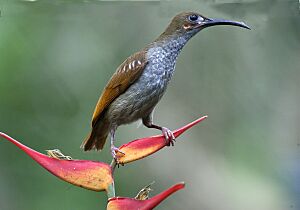Naked-faced spiderhunter facts for kids
Quick facts for kids Naked-faced spiderhunter |
|
|---|---|
 |
|
| Conservation status | |
| Scientific classification | |
| Genus: |
Arachnothera
|
| Species: |
clarae
|
The naked-faced spiderhunter (Arachnothera clarae) is a cool bird that lives only in the Philippines. It's part of the sunbird family, known for their long, curved beaks perfect for sipping nectar from flowers.
Contents
What Does the Naked-Faced Spiderhunter Look Like?
This bird is small to medium-sized. It has a long, curved beak that points downwards. Its feathers are mostly olive green. Its belly is pale yellow, and its wings are olive yellow. You might see faint stripes on its chest.
A special feature is a patch of orange skin around its beak. This bare skin gives the bird its unique name! Some birds in the eastern Philippines have an extra bare patch just above their beak. This spiderhunter looks a bit like the orange-tufted spiderhunter. But the naked-faced one is bigger and darker underneath. When it calls, it makes a rough sound, like "grrrrrrrrr!"
Where Does the Naked-Faced Spiderhunter Live?
The naked-faced spiderhunter lives only in the Philippines. There are four different types, called subspecies, found in different parts of the country:
- Arachnothera clarae luzonensis: This type lives in the Sierra Madre mountains on Luzon island in the northern Philippines.
- Arachnothera clarae philippinensis: You can find this one on the islands of Samar, Leyte, and Biliran in the eastern Philippines.
- Arachnothera clarae clarae: This type lives in the Davao area on Mindanao island in the southern Philippines.
- Arachnothera clarae malindangensis: This one is found in the middle and western parts of Mindanao island in the southern Philippines.
What Does the Naked-Faced Spiderhunter Do?
You can find the naked-faced spiderhunter in forests and bushy areas. It likes to live in low-lying places and on the lower parts of mountains. This bird especially loves to visit banana flowers. It probably sips the sweet nectar from them with its long beak.
Is the Naked-Faced Spiderhunter Safe?
Yes, this bird is doing well! It lives in many different places, and there are lots of them. The International Union for Conservation of Nature (IUCN) checks on animals around the world. They say the naked-faced spiderhunter is of "Least Concern." This means it's not in danger of disappearing.
How Did It Get Its Name?
The scientific name for this bird is clarae. We're not totally sure who this name refers to. But it might be named after Clara Blasius. She was the younger sister of August Wilhelm Heinrich Blasius, the scientist who first described this bird in 1890. Sadly, Clara passed away when she was very young.


